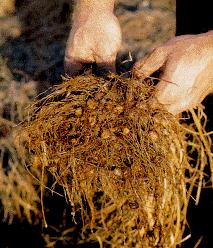Horchata from Chufa
This is the real thing - the original and ancient recipe for Horchata from Chufa (Tiger Nut). Horchata made from chufa nut tastes completely different than Mexican Horchata made from rice. Don't confuse the two because they have nothing in common.
History
 Pronounced [CHOO-fuh], the tiny, tuberous roots of a Middle-Eastern
plant of the sedge family, chufa "nuts" have their origin in ancient
Egypt. Chufa was one of the first domesticated crops and in fact, was found in vases in
the tombs of the ancient Egyptian pharos. The chufa nut was widely used in Egypt and
Sudan. The Arabs introduced the plant to Spain during the time of the Moorish kings (700
B.C. a 1200 A.D.). The eastern Spanish province of Valencia was the best for growing
chufa.
Pronounced [CHOO-fuh], the tiny, tuberous roots of a Middle-Eastern
plant of the sedge family, chufa "nuts" have their origin in ancient
Egypt. Chufa was one of the first domesticated crops and in fact, was found in vases in
the tombs of the ancient Egyptian pharos. The chufa nut was widely used in Egypt and
Sudan. The Arabs introduced the plant to Spain during the time of the Moorish kings (700
B.C. a 1200 A.D.). The eastern Spanish province of Valencia was the best for growing
chufa.
The nut is good for your health, with high levels of iron and potassium. It does not contain sodium and is valued for its minerals and vitamins.
Perhaps you would like to know where the name "Horchata" came from.
Well, there's an old story about a girl in a little town that offered some of the drink to the visiting King of Catalunya and Aragon. After enjoying the drink, the king asked, "Que es aixo?" (What is this?). The girl answered, "Es leche de chufa" (It's chufa milk - which was its original name), to which the King replied, "Aixo no es llet, aixo es OR, XATA!" (This is not milk, this is GOLD, CUTIE). The word "Xata" in Catalan - which the King spoke - is an affectionate nickname for a child.
The fame spread throughout the country and the name of the drink started to be known in Spanish as Orchata. Later, the H was added to the beginning.
Horchata remains a very popular and refreshing summer drink in the region of Valencia.
INGREDIENTS:
1 kg chufas
1 kg Sugar
5 liters of Water
1 Cinamon stick
- Clean the chufas very well, rinsing them in clean water.
- When they are completely clean, set them to seak in a lot of cold water for 12 to 14 hours.
- After this time, rinse the chufa again in clean water, changing the water until it is completely clear, then drain off all the water.
- Mash the chufa or put them in a blender - to make them into a soft paste. Add a little water if needed.
- Add the 5 liters of water to the paste that you have made and put in the cinnamon stick. Let it sit in a cool place (like a fridge) for 2 hours.
- Add the sugar and stir until the sugar is completely dissolved.
- Now, pass the mix through a metal mesh filter, and then through a wet, damp fine-cloth filter repeat until the strained liquid does not have any large particles left.
- You now have a fine, milky liguid that can be placed in the fridge to be served cold.
- You can also serve the Horchata in slushy form as you would ice-cream. Simply put it in the freezer, stirring occasionaly so it does not freeze solid.
This recipe came out perfect for me.
I can't give you much information on obtaining Chufa. It can be bought in Spain at little candy shops that sell nuts (frutos secos). I've even found it at Corte Inglés in bags. Chufa is grown in the Valencia area exclusively for Horchata.
I'm told that chufa is grown in the Southern United States and can be purchased through Farmer Co-Ops as seed. It is grown as a feed crop for cattle.
For more information on Horchata de Chufa, visit the webpage at: http://www.encis.es/chufa/horch.html
If you'd like to buy a liter of great tasting Horchata de Chufa imported from Valencia, there's a mail-order company in California that sells it. The name of the store is La Española, Inc. Their number is (310) 539-0455. A liter of real Horchata will cost you less than $5.
Real Food Recipes from Spain - http://www.xmission.com/~dderhak/recipes.html